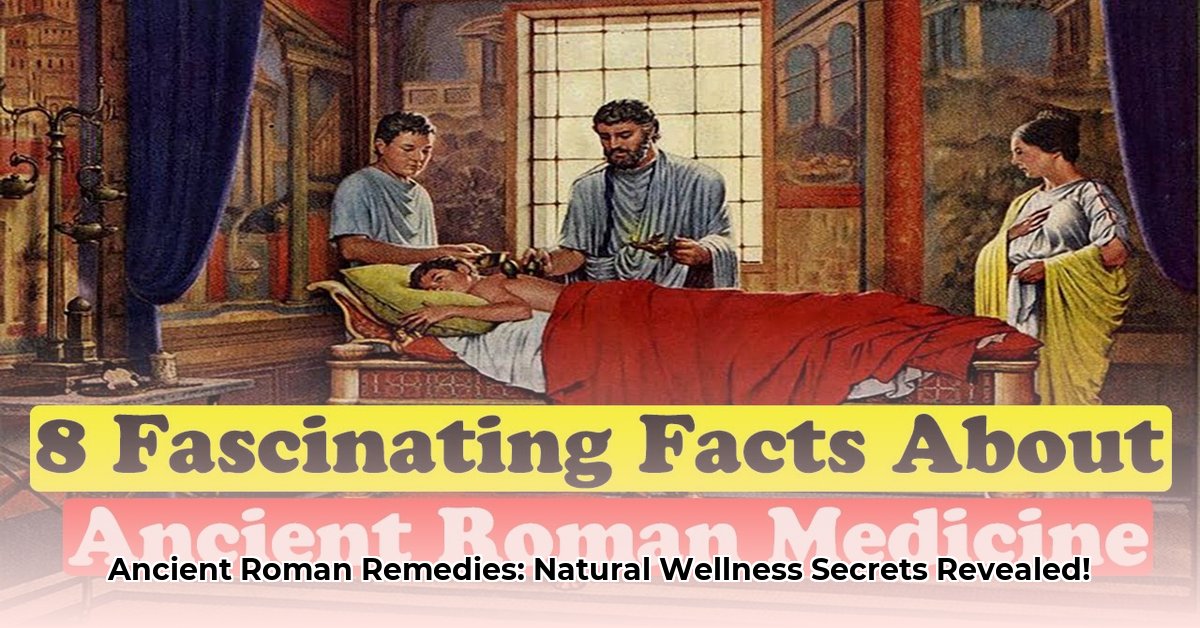Ever wondered how the ancient Romans navigated their health struggles, long before modern pharmacies and advanced diagnostics? Their approach was a fascinating blend of nature’s bounty, deeply held spiritual beliefs, and surprisingly forward-thinking public health initiatives. We are talking about a world where remedies from the garden, like cabbage for a hangover, were as common as a visit to the public baths. In this article, we will delve into pivotal Roman remedies, exploring their historical applications and what contemporary science might say about their efficacy today. We will also examine their remarkable advancements in public health, many of which still hold profound relevance. Ready to explore the ancient world’s approach to well-being? Remember, this exploration is purely for informational purposes and should not be considered medical advice. Always consult a healthcare professional before trying any new remedies or treatments.
The Foundations of Roman Medicine: A Blend of Traditions
Step back in time, and you will discover that ancient Roman medicine was a captivating fusion of empirical knowledge, deeply rooted religious convictions, and an emerging understanding of community welfare. Their efforts aimed to both treat illnesses and prevent their onset. The influence of Greek medical traditions, particularly the Hippocratic Corpus with its emphasis on diet, regimen, and surgery, was profound. Greek physicians like Archagathus of Sparta, credited as the first Greek doctor to practice in Rome in 219 BCE, brought new practices, though not always universally accepted by conservative Romans like Pliny the Elder, who called him the “Executioner” due to his surgical methods.
Eminent Roman and Greek scholars, including Aulus Cornelius Celsus, Galen of Pergamon, Dioscorides of Anazarbus, and the statesman Cato the Elder, meticulously documented the medical practices of their time. Galen, a prolific writer and physician, perfected his skills treating gladiators and became personal physician to several emperors, significantly advancing anatomical knowledge through animal dissections. Dioscorides’s De Materia Medica became the definitive text on herbal remedies for over a millennium. Roman medicine, though lacking a scientific understanding of germ theory, laid crucial groundwork through observation, practical application, and a holistic view that often integrated spiritual and physical well-being.
Nature’s Pharmacy: Unveiling Ancient Roman Herbal Remedies
Ancient Romans extensively utilized a variety of herbs and natural substances, drawing on centuries of accumulated wisdom. Many of these remedies were surprisingly effective, while others were based on erroneous beliefs, often linked to the humoral theory that posited health depended on the balance of four bodily fluids: blood, phlegm, yellow bile, and black bile.
Cabbage: The Roman Superfood and More
Imagine waking up after a festive Roman banquet and reaching for a head of cabbage instead of a modern pain reliever. This humble vegetable was not merely a dietary staple; Romans, particularly Cato the Elder, championed its use for preventing hangovers, soothing ulcers, calming gastritis, and even alleviating joint discomfort. Cato believed cabbage helped digestion, and even suggested bathing in the urine of someone who had eaten a lot of cabbage was beneficial. Intriguingly, modern research indicates that cabbage is rich in glucosinolates, compounds that suggest potential cancer-fighting properties. However, it is not without its drawbacks: cabbage might interfere with thyroid function and can cause bloating or gas in some individuals.
Peppermint: Digestive Aid and Soothing Agent
The Romans weren’t simply using peppermint to freshen their breath after a substantial meal. They also relied on it to assist with indigestion, coughs, and colds. Pliny the Elder recommended chamomile, a close relative of peppermint, for headaches and kidney ailments. Could they have intuitively known that peppermint might actually help mitigate the symptoms of Irritable Bowel Syndrome (IBS) and ease aching muscles? While the scientific understanding was absent, the observed benefits were likely evident. Nevertheless, a word of caution is prudent: for certain individuals, peppermint can exacerbate GERD (gastroesophageal reflux disease), and it has the potential to trigger allergic reactions.
Oregano: A Roman Antiseptic?
Among its many uses, the Romans employed oregano for more than enhancing culinary flavors. They also applied it as a remedy for various digestive and respiratory ailments. Was this merely an unproven folk remedy? Modern scientific inquiry, however, reveals that oregano contains both antimicrobial and antioxidant properties. This suggests a potential capability to combat infections and safeguard cells from damage. Even so, exercise caution with concentrated forms of oregano, as they may cause skin irritation.
Aloe Vera: Ancient Skin and Digestive Relief
Even in ancient Rome, the sun could be relentless! When overexposed, Romans turned to aloe vera to calm irritated skin. They also applied it for digestive issues and even in attempts to prevent hair loss. Today, we widely recognize aloe vera for its burn-healing and moisturizing attributes. Some studies further suggest it might contribute to the regulation of blood sugar levels. But do not overdo it! Excessive internal use of aloe vera can lead to diarrhea and potentially interact with certain medications. This versatile plant, celebrated for millennia, offers intriguing historical parallels to modern applications.
Fennel Seeds: A Multifaceted Spice
For the Romans, fennel seeds transcended a mere culinary accent. They utilized them as an expectorant to help clear coughs, and believed they could calm nerves, alleviate abdominal cramps, and soothe joint pain. Similarly, contemporary herbalists propose that fennel seeds can aid digestion and reduce bloating. Pliny the Elder advocated for its use for eye problems and sight. One important consideration, however: fennel seeds might heighten sun sensitivity in some individuals, and they could also interact with specific medicines.
Licorice: Sweet Relief with Hidden Risks
Ancient Romans commonly used licorice to address a range of conditions, including coughs, bronchitis, asthma, and various stomach problems. Interestingly, modern medicine acknowledges licorice for its potential to soothe sore throats and for its anti-inflammatory effects. However, licorice is not without its significant drawbacks. It has the capacity to elevate blood pressure, cause fluid retention, and negatively interact with heart medications. Furthermore, it is generally advised to be avoided during pregnancy.
Flax Seeds: Tiny Seeds, Enduring Benefits
The Romans valued flax seeds for their digestive benefits and their perceived role in preventing heart disease. Today, we recognize them as an excellent source of omega-3 fatty acids and for their potential to help lower cholesterol. However, a common side effect is that they can cause bloating and gas. They might also interfere with the body’s absorption of certain medications.
Garlic: The Potent Pungent Bulb
Garlic wasn’t just a staple in Roman cuisine; it held significant medicinal value. Galen believed garlic was a cure-all, and Pliny the Elder extolled its virtues for treating a wide array of conditions, from coughs to intestinal parasites. Current research strongly suggests that garlic possesses potent antimicrobial and antiviral properties, lending considerable credence to its ancient reputation.
Rosemary: For Memory and More
Rosemary, a fragrant herb often associated with remembrance, occupied a special place in Roman rituals and daily life. Beyond its culinary applications, it was also employed to enhance memory and sharpen cognitive focus, as documented by Dioscorides for its “warming faculty.” Modern studies indicate that rosemary may indeed improve cognitive function, attributed to its rich antioxidant and anti-inflammatory compounds.
Mint: A Breath of Fresh Air and Digestive Aid
Romans highly valued mint for its refreshing aroma and its remarkable ability to soothe digestive upsets. The poet Ovid even mentions it as a symbol of hospitality. Today, we continue to rely on mint for its calming effects on the stomach and its capacity to freshen breath.
Thyme: Courage and Respiratory Aid
Beyond its well-known culinary uses, thyme held symbolic significance in Roman culture, representing courage and strength. Soldiers reportedly bathed in thyme-infused water, believing it would invigorate them for battle. More practically, it was also used to alleviate respiratory problems and treat various skin infections. Thyme is widely recognized for its antiseptic and expectorant properties and remains an active ingredient in many modern cough syrups.
Sage: The Sacred and Healing Herb
The Romans revered sage as a sacred herb, attributing potent healing properties to it. The name Salvia derives from the Latin “salvare” or “salus,” meaning “to heal” or “health.” They utilized it traditionally to treat snakebites, enhance fertility, and even preserve food. Modern scientific investigations have, in fact, validated some of these historical uses, revealing that sage contains beneficial compounds with antioxidant, anti-inflammatory, and antimicrobial effects.
Yarrow: Ancient Wound Healer
Homer’s Iliad features Achilles treating his friend’s wounds with yarrow, a story that would have made its use common knowledge in the Roman world. Modern research shows yarrow is an astringent, anti-inflammatory, and speeds healing.
Marshmallow: Soothing Inflammation
Used medicinally for over 2,000 years, marshmallow pollen has been found at Roman forts. Pliny suggested it as an ointment or cough syrup. Arabian doctors used poultices from its leaves for inflammation, and Roman doctors employed it for toothaches and insect bites. Its slimy properties were also recognized for soothing coughs and irritated skin.
Blackberry: Remedy for Digestive Woes
Galen and the Greeks saw blackberry as useful for gout. Pliny recommended drinking a decoction of blackberry leaves and bark to treat dysentery, a common problem for Roman armies. Chewing a leaf was thought to help with bleeding gums. Modern analysis confirms that blackberry leaves contain high levels of tannins, an astringent that can control diarrhea and bleeding gums.
Wine: The Universal Medicinal Solvent
Wine was a frequent component of ancient Roman medicine. As we know today, alcohol is an excellent means of extracting active elements from medicinal plants. Herbs infused in wine was a regular medicinal strategy, effective due to alcohol’s ability to extract compounds. For example, Artemisia Abrotanum (Southernwood) was regarded as an antidote for poison when taken with wine.
Summary of Ancient Roman Remedies: A Word of Caution
| Remedy | Ancient Roman Use(s) | Modern Potential Applications (based on research) | Potential Risks/Cautions |
|---|---|---|---|
| Cabbage | Hangover prevention, ulcers, gastritis, joint pain | Cancer prevention, digestive aid | Thyroid interference, bloating, gas |
| Peppermint | Indigestion, coughs, colds | IBS relief, muscle pain, nausea | GERD aggravation, allergic reactions |
| Oregano | Digestive/respiratory ailments, antiseptic | Antimicrobial, antioxidant | Skin irritation (concentrated forms) |
| Aloe Vera | Skin irritation, digestive issues, hair loss | Burn healing, moisturizing, blood sugar regulation | Diarrhea, medication interactions, allergic reactions (if applied topically too frequently) |
| Fennel | Coughs, nerves, abdominal cramps, joint pain, eye health | Digestion aid, bloating reduction | Photosensitivity, medication interactions |
| Licorice | Coughs, bronchitis, asthma, stomach problems | Sore throat relief, anti-inflammatory | Blood pressure increase, fluid retention, heart medication interactions, pregnancy risk (avoid during pregnancy) |
| Flax Seeds | Digestion, heart disease prevention | Omega-3 source, cholesterol lowering | Bloating, gas, medication absorption interference |
| Garlic | Coughs, intestinal parasites, general cure-all | Antimicrobial, antiviral, immune support | Bad breath, body odor, increased bleeding risk (in large doses) |
| Rosemary | Memory enhancement, cognitive focus, warming faculties | Cognitive function improvement, antioxidant, anti-inflammatory | Seizures (in high doses), allergic reactions, medication interactions (e.g., blood thinners) |
| Mint | Digestive upsets, bad breath | Calming effects on stomach, breath freshener | Heartburn (for some), allergic reactions |
| Thyme | Respiratory problems, skin infections, courage | Antiseptic, expectorant | Allergic reactions, skin irritation (topical), potential for gastrointestinal upset |
| Sage | Snakebites, fertility, food preservation | Antioxidant, anti-inflammatory, antimicrobial | Nausea, vomiting, dizziness (in large doses), interacts with certain medications (e.g., sedatives, diabetes medications) |
| Yarrow | Wound healing, blood staunching | Astringent, anti-inflammatory | Allergic reactions (especially for those with ragweed allergy), increased photosensitivity, may interact with blood thinners |
| Marshmallow | Coughs, inflammation, digestive issues, skin irritation | Soothing agent for coughs, skin, digestive tract | Allergic reactions, may slow absorption of other medications if taken concurrently |
| Blackberry | Gout, dysentery, bleeding gums | Antidiarrheal, astringent, anti-inflammatory | Allergic reactions, potential for constipation if overused |
| Wine | Solvent for herbal remedies, various specific ailments | Extracting compounds from herbs, antiseptic (topical) | Alcohol intoxication, dependency, drug interactions (when combined with herbs), not for internal use in modern medical practice unless highly diluted |
Beyond Herbs: Other Roman Treatments and Peculiar Practices
While herbal remedies formed a significant part of Roman medicine, their practices also included less conventional or even bizarre treatments, often rooted in superstition or a flawed understanding of human anatomy and disease.
One of the most macabre remedies was the consumption of warm blood or liver from a slain gladiator, prescribed for epilepsy. Roman scholar Pliny the Elder reported, “The blood of gladiators is drunk by epileptics as though it were the draught of life.” This practice likely stemmed from a belief in the gladiator’s virility transferring to the sick, rather than any scientific basis. Similarly, the court physician of Emperor Theodosius advised patients to wipe their faces with a cloth while “a shooting star falls” to remove pimples, expecting them to “fall off the face.”
Other animal-based remedies were equally strange: headaches might be treated by sprinkling wine that had a crow’s head inside, or by touching an elephant’s anointing rod to the head (more effective if the elephant sneezed). The severed genitals of a fox were a last resort for stubborn headaches. Warts might be treated by rubbing them with mouse dung, swan fat, or even by touching a pea to each nodule, then wrapping the peas and throwing them backward. Constipation remedies included preserved wolf’s gall in honey, or bull’s gall mixed with wormwood. Even the smell of a she-bear, especially after giving birth to a male, was thought beneficial for those about to have a seizure.
Roman doctors, like Galen, also considered dreams in their diagnoses, believing they could signal humoral imbalances. For instance, dreams involving snow or ice were thought to indicate an excess of phlegm (cold and wet humor), while fire signaled elevated bile (hot and dry). Such practices highlight the blend of empirical observation and mystical belief.
Engineering Health: Roman Public Health Innovations
Beyond focusing on individual cures, the Romans excelled in public health, pioneering infrastructure and systems that resonate powerfully even now. Their dedication to collective well-being was truly remarkable for their era.
Aqueducts, awe-inspiring feats of engineering, meticulously channeled fresh, clean water from distant sources into their bustling cities for both drinking and sanitation purposes. It was an essential innovation for sustaining urban life and preventing waterborne diseases. Following this, their advanced sewer systems, most notably the Cloaca Maxima, Rome’s foundational main sewer, stood as an engineering marvel crucial for maintaining urban hygiene. These systems efficiently removed waste from public and private buildings, significantly reducing disease vectors.
The Romans had an undeniable affinity for their public baths, and their purpose extended far beyond mere bodily cleansing. These baths served as vital communal hubs, fostering a strong sense of community while simultaneously promoting personal hygiene, a fundamental aspect of disease prevention. Think of them as the social media platforms of their era, but instead of digital connection, they offered tangible cleanliness and social interaction.
The Romans were not just adept at constructing magnificent structures; they also established and enforced rigorous regulations to ensure the smooth operation and maintenance of their public health systems. They implemented and strictly enforced sanitation standards to uphold urban hygiene, including regulations for waste disposal. Furthermore, they even utilized rudimentary quarantine measures to effectively control the spread of contagious diseases, a concept that has become strikingly familiar to us in modern times.
Emperor Augustus established one of the first professional military medical corps, attracting professional Greek doctors with rights of full Roman citizenship, tax exemptions, and retirement pensions. This medical corps formed one of the first dedicated field surgery units, erected well-designed sanitation systems within camps, and pioneered innovations like the hemostatic tourniquet to stop hemorrhaging and instruments to shut arteries for suturing. Camp doctors stood at the empire’s medical vanguard, absorbing new ideas through
- Unlock ancient roman remedies: Natural treatments revealed for modern wellness. - August 17, 2025
- Unlock History: Ancient Roman Coin Necklace Trends & Buys - August 17, 2025
- Beyond Gladiators: Achievements in Ancient Rome Still Shaping Our World - August 17, 2025
















